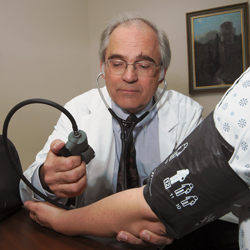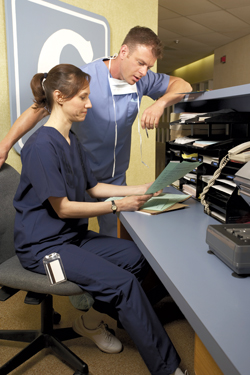Expert explains thyroid diagnosis, treatment and common red flags
The estimate that 25 million people have thyroid problems would double if the normal range was adjusted, as some medical societies suggest. In this Web-only feature, Victor Bernet, FACP, the author of MKSAP 15's chapter on disorders of the thyroid gland, offers his insights into management.
January is thyroid disease awareness month, and awareness is warranted. There are currently an estimated 25 million people in the U.S. with all kinds of thyroid problems, hyper- and hypothyroid. But if the upper limit of the normal range of the thyroid-stimulating hormone (TSH) test were reduced from 5.0 mIU/L to 3.0 mIU/L, as recommended by some professional societies, an additional 22 million to 28 million people would be considered hypothyroid. And others with thyroid problems may not yet be diagnosed because these conditions are tricky to discern.
Victor Bernet, FACP, is Director of the National Capitol Consortium Endocrinology Fellowship at Walter Reed Army Medical Center in Washington, D.C., and the author of MKSAP 15's chapter on disorders of the thyroid gland. He recently offered his insights on why thyroid disorders go undiagnosed, what alternative treatments are available, and how primary care physicians and specialists can work together to manage thyroid disease.
Q: It is estimated that more than 25 million Americans have thyroid disease, and as many as half the people with thyroid problems don't even know it. In your view, what are the main reasons why so many thyroid disorders go undiagnosed?
A: I think the number is large because it includes mild cases of hypo- and hyperthyroidism as well as nodules that don't necessarily have symptoms, and when they do, they come on so slowly that people misattribute them to other things. Take for example an elderly person with hypothyroidism. They may attribute their fatigue to normal aging.

Clinically significant cases of thyroid disease are often missed because we don't screen for thyroid disease in the U.S. That's because the U.S. Preventive Services Task Force (USPSTF) concluded that screening asymptomatic people with blood tests like TSH does not ultimately improve outcomes. However, some professional groups like the ATA (American Thyroid Association) and the ACP (American College of Physicians) think it's prudent to screen at-risk subgroups such as the elderly, pregnant women, children with genetic syndromes like Down's or Klinefelter's, or people with a family history of autoimmune thyroid disease (e.g. Hashimoto's thyroiditis or Graves Disease).
Q: Should thyroid self-exams be recommended to the general population? What are the chances that a self-exam will turn up something clinically relevant?
A: Studies have shown that in patients between the ages of 50 and 60, a physician's clinical neck exam had only an 8% chance of detecting a nodule. With ultrasound, detection dramatically increases. It's estimated that thyroid nodules are naturally occurring in about 40% of 65-year-olds. But most of those nodules aren't clinically relevant, so ultrasound screening is not recommended for the general population.
The AACE (American Association of Clinical Endocrinologists) does recommend thyroid self-exams and offers pamphlets to patients who want to check their own necks. However, research hasn't shown that self-exams help to find clinically significant disease early nor improve outcomes. Still, thyroid self-exams don't have much of a downside, although patients and even primary care doctors sometimes feel things incorrectly, and unnecessary evaluations to include biopsies can result. For example, neck cartilage can be mistaken for a nodule.
Q: There seems to be some controversy regarding how to diagnose hypothyroidism. Some say TSH is sufficient. Others also check free T3 and T4, while others may have different ideas about TSH levels required for a diagnosis of hypothyroidism. What does the current evidence suggest about how doctors should perform and interpret thyroid tests?
A: TSH is a great screening test for patients who have no symptoms. However, once a patient is complaining of symptoms of hypothyroidism, then you need to get a free T4 level along with the TSH. That will assure that you don't miss a rare “central hypothyroidism” where the TSH may not be reliable.

As far as free T3 levels are concerned, they usually aren't affected until hypothyroidism is extremely severe, so free T3 doesn't really have a role in the hypothyroid patient. It's a more relevant test for hyperthyroid patients.
As far as TSH goals are concerned, historically the normal range has been about 0.45 mIU/L or 0.5 mIU/L to 4.5 mIU/L or 5.0 mIU/L. However, the very large NHANES study showed that actually most Americans, especially those confirmed not to have any underlying thyroid disease, have TSH levels between 0.5 mIU/L to 2.5 mIU/L, so we began to think of normal TSH as being in that narrower window. New research also suggests that TSH levels rise naturally as we age, and we've also found that normal TSH levels may vary slightly by race, with African-Americans having slightly lower TSH levels than Caucasians. This can get pretty confusing. Even if we opt for the narrower window as our normal baseline (so that asymptomatic people with TSHs above 3 are diagnosed with hypothyroidism), an improvement in outcomes should be shown before applying this universally..
Once a person is diagnosed with hypothyroidism, however, there is general agreement that keeping their TSH in a narrow therapeutic window (about 0.5 mIU/L to 2.5 mIU/L or 3.0 mIU/L) is clinically valuable.
Q: Many patients wonder if being overweight has something to do with their thyroid function. At what point is it appropriate to test their thyroid function?
A: The vast majority of obese patients do not have a definable endocrine abnormality. I usually check to see if the patient has any other symptoms of hypothyroidism (other than weight gain) before I order a TSH screening test. Things like constipation or dry skin would raise my concern for hypothyroidism, though it's not unreasonable for primary care physicians to order screening TSH tests on patients who are gaining weight and specifically want their thyroid function tested.
Q: Tell me about the most popular alternative medicines for thyroid disease and the evidence, if there is any, for their use.
A: First of all, the thyroid gland primarily makes T4, and just a little bit of T3. T3 is the active thyroid hormone that controls metabolism, etc. and is created through peripheral conversion of T4 to T3. Levothyroxine is primarily T4, so people have been theoretically interested in giving T3 directly as an alternative. There was a study in 1999 that showed some potential benefits of giving a combination of T4 (Synthroid) and T3 (Cytomel) agents. However, a 2006 meta-analysis of 11 research studies showed that there was no evidence of benefit of combination T4 and T3 regimens.
Armour Thyroid (Forest Pharmaceuticals, Inc.) is desiccated animal thyroid gland and some people prefer it to synthetic thyroid hormone. However, the problem with Armour Thyroid is that the ratio of T4 to T3 thyroid hormone it contains can vary from batch to batch. I've had patients complain of palpitations and nervousness at times and studies reveal that blood levels of T3 can fluctuate substantially with T3-containing regimens in comparison with levels seen in patients with normal thyroid function or taking T4 preparations.
As far as a thyroid diet is concerned, we have no evidence that any particular diet specifically helps thyroid function. Of course, people need to consume sufficient quantities of iodine or else goiters can result.
Q: Do you see a lot of patients who self-diagnose hypothyroidism through a Google search?
A: Yes. The symptoms of hypothyroidism are often non-specific. Weight gain and fatigue are very prevalent in general. I often find that people are trying to get by on six hours of sleep, eating poorly, and not exercising, and then they complain of fatigue and weight gain and want to ascribe it to a thyroid problem. That being said, the occasional patient does correctly self- diagnose themselves with hypothyroidism based on information obtained on-line or in books.
Q: What is the best advice to give a patient with hypothyroidism when they complain that their T4 agent is not making them feel fully well?
A: Again, I'd want to find out more about their sleep, diet and exercise habits. I'd also make sure their TSH was in an optimal therapeutic range and that they were taking their medicine at regular intervals. Calcium and iron can bind thyroid hormone in the gut so it's important not to take levothyroxine with vitamin supplements, and proton-pump inhibitors can also reduce their absorption. I also like to remind patients that it can take four to six weeks before thyroid hormone levels normalize after starting therapy or changing a thyroid hormone dose.
Patients with Hashimoto's thyroiditis need to be aware that they're at higher risk for other autoimmune disorders like type 1 diabetes, lupus, rheumatoid arthritis or adrenal insufficiency.
Q: When should a primary care physician refer a thyroid patient to an endocrinologist?
A: Most patients with thyroid disease can be handled very well by a primary care physician. If the PCP notices that the blood tests are atypical and don't fit a regular pattern, or if a patient is refractory to treatment with thyroid function tests all over the board, or if the PCP finds an anatomic abnormality (like an enlarged or lumpy thyroid gland), they should refer the patient to an endocrinologist.
Q: Is there anything that you wish PCPs would do before referring patients to you?
A: It's best to have a specific question for the endocrinologist. Also, if thyroid function tests are mildly abnormal, you may wish to repeat them after a short interval to make sure it's not a lab error (or a variation due to illness) before referring the patient to an endocrinologist.
If the patient has a couple of abnormal TSH levels and a family history of autoimmune thyroid disease, it'd be appropriate to order an anti-thyroid antibody panel (TPOAb) before referring the patient to the endocrinologist. We also like to see a CBC, Chem 20, and lipid panel because they all can be impacted by hypothyroidism depending on how severe it is.
Q: How do you find the right balance between allowing the PCP to manage the patient versus providing specialty help and input?
A: I think there should be one cook in the kitchen when you're trying to negotiate changes in thyroid function tests and adjust medication dosing. The endocrinologist should communicate to the PCP what the TSH goal is and why they're taking the therapeutic approach they've chosen, and manage the patient during the period of time in which the medication is being adjusted. Once the TSH is in a good therapeutic window, the endocrinologist may well transfer management back to the PCP until there's a new problem or concern.




